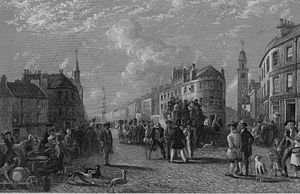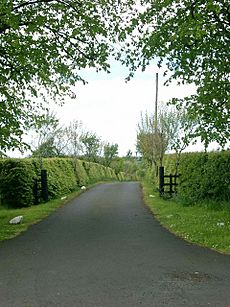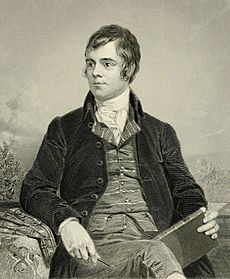Robert Muir of Loanfoot facts for kids
Quick facts for kids
Robert Muir
|
|
|---|---|

Kilmarnock Cross in 1840
|
|
| Born | 1758 Loanfoot, East Ayrshire, Scotland
|
| Died | 22 April 1788 Kilmarnock, Scotland
|
| Occupation | Wine and spirit merchant |
Robert Muir (1758–1788) was a close friend and supporter of the famous Scottish poet Robert Burns. He was born around 1758 at Loanfoot, near Kilmarnock in East Ayrshire, Scotland. Robert Muir owned land and also worked as a wine and spirit merchant. Robert Burns even wrote a poem about him called "Epitaph on Robert Muir."
Contents
Robert Muir's Life Story
Loanfoot House, where Robert Muir's family lived, no longer exists today. Only a street name, Loanfoot Avenue, reminds us of where it once stood. When Robert took over the family estate from his father, it had many debts. But by the time he died, he had managed to pay them off. He also ran a business selling wine and spirits in Kilmarnock. Robert was not very strong and sadly died in 1788 at just 29 years old. He passed away from a serious illness called tuberculosis.
The Beanscroft Devil Mystery
One very strange story involves Robert Muir and a man known as John Goldie the 'Philosopher'. It's called the 'Beanscroft Devil' tale and happened around the time of Robert Burns.
Beanscroft Farm is located a few miles from Kilmarnock. The farmer there was known as a good and honest person. However, strange things started happening at his farmhouse and in the barns. The farmer and his family became convinced that the Devil himself was bothering them.
At first, the strange events were small, like sounds or movements that could be explained by the wind. But then, furniture began to move, and they heard weird shrieks and howls. Lights of different colors appeared, and ropes holding the cattle broke without being cut. These things were very hard to explain. The farmer's son tried to solve the mystery, but his parents were too scared to leave the house.
John Goldie, the 'Philosopher', believed in God but not in the Devil being on Earth. He said he could solve this mystery using logic, like a detective. The farmer invited him to the farm. Goldie came with his friends, Mr. Gillies, a minister, and Robert Muir, a merchant and church elder from Kilmarnock.
Goldie asked questions about possible enemies the farmer might have. He also looked closely at the broken ropes. He then announced that a human, not the Devil, was behind these events. He made the farmer promise to keep a secret. Goldie told him to hide in the barn that night.
When it got dark, the farmer hid as he was told. He soon heard the usual strange noises. Suddenly, he saw a shadowy figure holding a trumpet-like object. This person was making the scary sounds. The farmer rushed forward and caught the culprit. To his surprise, it was his own son!
It turned out the son knew a bit about chemistry. He had made what we now call colored fireworks. He had also used a strong liquid called Aqua Fortis (now known as Nitric Acid) to cut the ropes. John Goldie had figured out that the son wanted to scare his father into retiring. This way, the son could take over the farm. The 'philosopher' became very famous for solving the mystery. The son was so embarrassed that he left the area and was never seen there again.
Robert Burns and Robert Muir's Friendship
Robert Muir first met the poet Robert Burns in 1786. This was probably at the Bowling Green House Inn in Kilmarnock. Robert Muir was a big supporter of Burns. He bought 72 copies of Burns' first book of poems, the 1786 Kilmarnock volume. He also bought 40 copies of the next edition published in Edinburgh in 1787. This shows how much he helped Burns get his poems published.
Burns told Muir about the birth of his first twins. On September 8, 1786, Burns wrote to Muir: "My Friend My Brother, You will have heard that poor Armour has repaid my amorous mortgages double. A very fine boy and girl have awakened a thousand feelings that thrill, some with tender pleasure, and some with foreboding anguish, thro' my soul."
Burns wrote a special poem called "Epitaph on Robert Muir":
What Man could esteem, or what
Woman could love,
Was He who lies under this sod:
If Such Thou refusest admittance above,
Then whom wilt thou favor, Good God!
Robert Muir's death at a young age deeply affected Robert Burns. Burns' brother, Gilbert Burns, said that Muir was one of Robert's closest friends in Kilmarnock. Burns hoped to meet Muir again in the afterlife. He wrote that Muir was "the disinterested friend of my early life: the man who rejoiced to see me, because he loved me and could serve me." Burns praised Muir's kind and noble heart.
Letters from Robert Burns
The letters Burns wrote to Robert Muir show how important their friendship was. They also give us a look into Burns' personality.
In a letter from March 20, 1786, Burns included a copy of his poem "Scotch Drink." He also talked about plans to meet up: "I hope, sometimes before we hear the Gowk [Scots for a cuckoo], to have the pleasure of seeing you, at Kilmarnock, when, I intend we shall have a gill between us, in a Mutchkin-stoup, which will be a great comfort and consolation."
On November 18, 1786, Burns sent Muir a short note with a copy of his poem "Tam Samson's elegy."
From Edinburgh, on December 15, 1786, Burns wrote: "I am still undetermined as to the future; and, as usual, never think of it. I have now neither house nor home that I can all my own, and live on the world at large. I am just a poor wayfaring Pilgrom on the road to Parnassus; thoughtless wanderer and sojourner in a strange land."
On December 20, 1786, Burns wrote to Robert again. Muir had tried to buy 60 copies of the Edinburgh Edition of Burns' poems. But Burns knew Muir didn't have much money. So, he refused and only let him buy 40 copies. Burns wrote: "Your affair of sixty copies is also like you: but it would not be like me to comply."
In 1787, Burns wrote from Stirling. He shared his strong feelings about visiting the tomb of Sir John Graham, a hero with Sir William Wallace. He also visited the site of the Battle of Bannockburn, where Robert the Bruce raised his flag.
On March 7, 1788, Robert Burns wrote to Robert Muir. He shared his religious beliefs in detail. He also hoped that "the Spring will renew your shattered frame and make your friends happy."
Burns wrote: "If we lie down in the grave, the whole nun a piece of broke machinery, to moulder with the clods of the valley — be it so; at least there is an end of pain, care, woes and wants: if that part of us called Mind, does survive the apparent destruction of the man - away with old-wife prejudices and tales! Every age and every nation has had a different set of stories; and as the many are always weak, of consequence they have often, perhaps always been deceived: a man, conscious of having acted an honest part among his fellow creatures; even granting that he may have been the sport, at times of passions and instincts; he goes to a great unknown Being who could have no other end in giving him existence but to make him happy; who gave him those passions and instincts, and well knows their force."
Quick Facts
- Robert Muir was a church elder in Kilmarnock.
- Burns said that Gilbert Kerr of Stodrig Farm reminded him of Robert Muir.
See also



